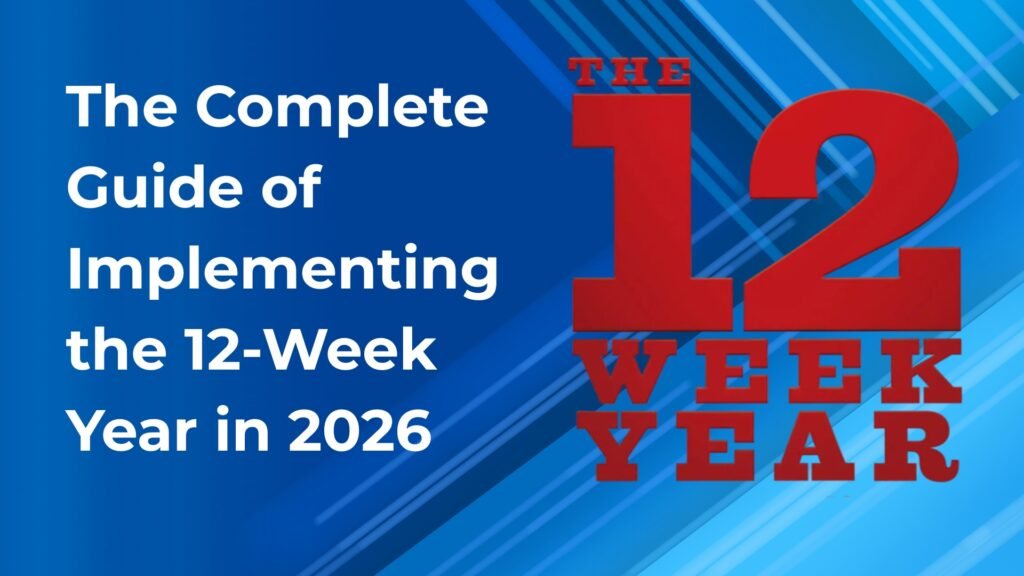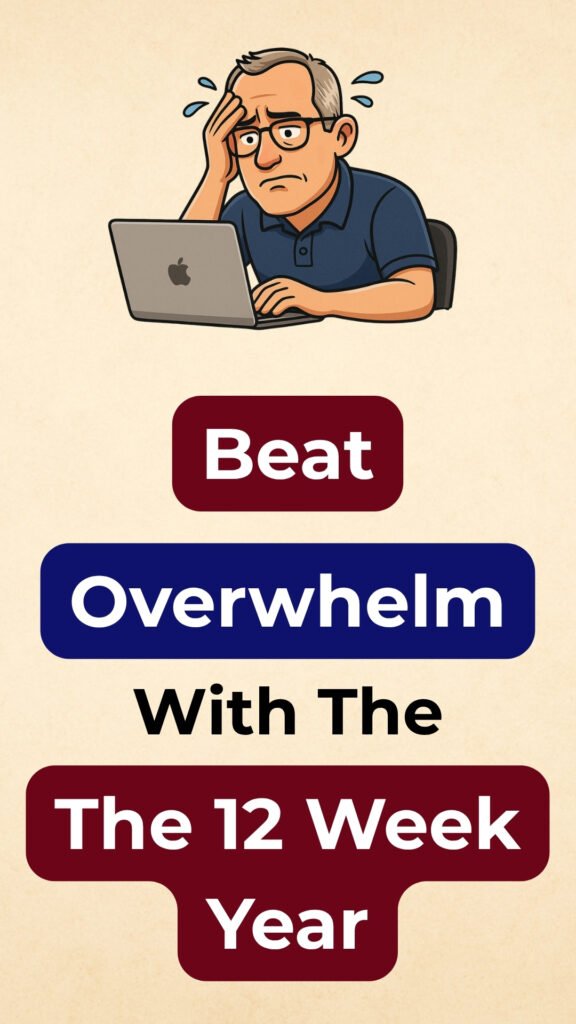
Nov. 4th, 2025


Written by Dan Mintz, a leading productivity strategist, expert in the 12 week year, and the founder of the 12-Week Breakthrough Program. Wharton MBA, MIT Data Scientist, 3x Entrepreneur.
Worked with dozens of people to transform their lives in 12 weeks.
Most professionals today live in a constant state of overwhelm.
They’re not lazy, undisciplined, or unmotivated — they’re operating in a system that simply doesn’t work.
According to Microsoft Research, the average knowledge worker is interrupted more than 275 times a day — through emails, chats, notifications, and meetings. Each interruption fragments attention, erodes focus, and leaves a residue of cognitive fatigue.
The result?
People aren’t just busy — they’re scattered.
And this overwhelm has become so normalized that many mistake it for the price of ambition.
But it’s not.
Overwhelm isn’t emotional — it’s structural.
And that means it can’t be solved with motivation, willpower, or hacks.
It requires a systematic redesign of how you operate.
While every professional’s experience is unique, the root causes are remarkably consistent.
Here are the most common structural drivers of overwhelm:
We are inundated with information — emails, messages, Slack threads, project updates, and notifications.
This constant input floods our limited working memory, producing cognitive overload.
Even when you’re not actively multitasking, your brain is still processing unfinished fragments, leaving little capacity for deep, meaningful work.
Without clear goals, every task feels equally urgent.
You respond to whatever is loudest rather than what matters most.
Ambiguity creates anxiety, and anxiety fuels distraction — a cycle that repeats daily.
Modern professionals are often managing workloads that exceed realistic capacity.
When everything feels important, focus becomes impossible.
This leads to stress, constant reactivity, and a chronic sense of falling behind.
Constant context switching doesn’t just waste time — it prevents the brain from entering sustained, high-performance focus.
Without built-in recovery rhythms, mental fatigue accumulates and decision quality declines.
These problems don’t exist in isolation.
They feed each other.
Information overload leads to unclear priorities. Unclear priorities fuel overwork. Overwork eliminates recovery.
The result is a self-reinforcing loop of exhaustion.
And this loop isn’t emotional — it’s systemic.
Most productivity advice fails because it treats symptoms, not systems.
Hacks like “try this app,” “wake up earlier,” or “use a Pomodoro timer” can offer short bursts of relief, but they don’t address the architecture of work itself.
Here’s why these quick fixes don’t work:
They lack integration. A new tool or trick doesn’t change the underlying workflow.
They rely on discipline. Motivation fades under stress; systems endure.
They ignore feedback loops. Without clear metrics and review cycles, there’s no way to adapt or improve.
If your work environment is fragmented, adding another layer of optimization will only increase friction.
The real solution is not to do more — but to redesign the system in which you operate.
That’s where the 12-Week Year — and its upgraded version, the 12-Week Breakthrough — comes in.
It’s not another productivity tool; it’s a complete operating system for focus, clarity, and sustainable performance.
The premise is simple but profound:
Instead of treating the year as 12 months, treat it as 12 weeks.
Each 12-week period becomes a self-contained “year” with its own goals, metrics, planning, and reflection.
This creates natural cycles of urgency, feedback, and renewal — eliminating the long, unstructured drift that causes burnout and loss of momentum.
Here’s how it addresses the main causes of overwhelm:
You begin by defining a 3-year vision and translating it into measurable 12-week goals.
This anchors every task to a bigger purpose and eliminates ambiguity.
You stop reacting to noise and start acting with precision.
Instead of a chaotic to-do list, you operate within a robust weekly plan built around Most Important Tasks (MITs) — the few activities that create 80% of your results.
This structure filters out low-value work and naturally reduces interruptions.
Each 12-week cycle is long enough to achieve meaningful results but short enough to maintain focus and urgency.
This structure also embeds recovery — every 13th week is a reflection and renewal phase, ensuring balance and preventing fatigue.
Every week, you track lead and lag indicators.
Lead indicators measure what you control (actions taken), while lag indicators measure outcomes (results achieved).
This creates real-time awareness, accountability, and the ability to course-correct early — something annual goals can’t provide.
By aligning vision, planning, execution, and measurement into one cohesive framework, the 12-Week Breakthrough doesn’t just help you manage overwhelm — it eliminates its structural causes.

The 12-Week Breakthrough isn’t based on intuition; it’s grounded in research from multiple disciplines:
The result is a model that aligns psychological principles with practical execution — clarity for the mind, structure for the day, and rhythm for the long term.
You can start applying the principles immediately.
Write a one-page 3-year vision describing who you are becoming, what success looks like, and how it feels.
This shifts focus from tasks to identity — from what you’re doing to who you’re becoming.
Choose no more than three major objectives.
Each goal should be specific, measurable, and outcome-focused (e.g., “Increase client revenue by $60,000” or “Publish 12 educational videos”).
Break each goal into 3–5 Most Important Tasks per week.
Schedule them into Strategic Blocks (3-hour deep work sessions), Buffer Blocks (for admin and communication), and Breakout Blocks (for recovery).
Use a weekly scorecard to track completion rates.
Hold a brief Weekly Accountability Meeting (WAM) — even if it’s just with yourself — to review progress, identify obstacles, and plan the next week.
At the end of each 12-week cycle, pause.
Analyze what worked, what didn’t, and what you’ll carry forward.
This reflection creates learning loops — the engine of sustainable growth.
Yes. While mindset influences behavior, overwhelm primarily stems from fragmented workflows, lack of clarity, and constant cognitive switching. Once structure and rhythm are restored, mental calm follows naturally.
Traditional methods focus on efficiency — doing more in less time.
The 12-Week Breakthrough focuses on effectiveness — doing only what matters most, within a focused framework of execution, measurement, and recovery.
Twelve weeks strikes the balance between urgency and achievability.
A month is too short to produce meaningful results; a year is too long to maintain focus.
Twelve weeks create a natural horizon for progress.
Absolutely. Teams can align on shared 12-week goals, review progress weekly, and maintain accountability through scorecards and WAMs. It enhances collaboration and transparency.
It integrates concepts from Deep Work (Cal Newport), Digital Minimalism, and Slow Productivity — embedding rhythm, focus, and recovery into execution cycles.
Because each 12-week cycle includes review and reflection, the system is inherently adaptive.
You learn, adjust, and reset quickly — agility built in by design.
That’s the signal you need this system most.
It forces trade-offs and focus. Limiting yourself to 1–3 goals drives clarity and removes false urgency.
Most people see measurable improvements — in focus, control, and output — within the first 4–6 weeks of implementing the system.
Yes. Use any platform you prefer (Notion, Asana, ClickUp), but let the 12-Week Breakthrough provide the structure. Tools support the system; they don’t replace it.
To move from reactivity to intentionality — to manage progress instead of time, and to design your weeks around the work that truly matters.
Overwhelm isn’t a sign of weakness.
It’s a signal — that your system has reached its limits.
Once you stop fighting symptoms and start redesigning the structure, everything changes.
You gain control, focus, and clarity — not through effort, but through design.
That’s the essence of the 12-Week Breakthrough:
turning chaos into clarity, one 12-week cycle at a time.
A goal defines a specific outcome (e.g., “lose 5 kg” or “launch a product”).
A vision defines direction — the identity, lifestyle, and meaning you’re moving toward.
In the 12 Week Year, vision acts as your “north star” that guides every 12-week cycle.
Because they confuse inspiration with execution.
A vision feels powerful at first but fades without a structured process.
The 12 Week Year bridges this gap by turning inspiration into a 12-week execution loop.
Frankl taught that purpose is humanity’s greatest motivator.
When you define why your goals matter, your effort becomes meaningful — and sustainable.
The 12 Week Year operationalizes this by translating that meaning into measurable weekly actions.
Hershfield found that people treat their future selves as strangers, causing procrastination.
By collapsing your timeline to 12 weeks, the 12 Week Year helps you emotionally connect to your near-future self — creating urgency and empathy for tomorrow’s you.
Duckworth showed that sustained effort over time beats short bursts of intensity.
The 12 Week Year builds grit by cycling through consistent 12-week sprints — small enough to maintain focus, long enough to create compounding results.
Every 12 weeks.
At the end of each cycle, reflect on progress, refine clarity, and re-anchor your emotional connection to your vision.
Vision is alive — it should evolve with every breakthrough.
A year is too long to feel urgent and too vague to guide daily action.
Twelve weeks compress time, create focus, and enable measurable progress loops.
You plan, execute, and adjust four times faster.
Yes — but pick one primary domain per cycle (career, health, business, etc.).
You can maintain small “maintenance habits” elsewhere, but focus drives transformation.
Writing vague, abstract statements with no emotional weight.
Setting too many goals per 12-week cycle.
Ignoring reflection or scorekeeping.
Letting their “why” fade from awareness.
Use the MIT method (Most Important Tasks).
Each week, identify 3–5 actions that move your 12-week goals forward — those, in turn, move your vision forward.
If it’s not on your weekly plan, it’s probably not part of your vision.
By shortening your time horizon, you eliminate the illusion of “plenty of time.”
Each week feels consequential.
Combined with weekly scorekeeping and accountability meetings (WAMs), procrastination has nowhere to hide.
A WAM is a 15–30 minute session (solo or with a partner) where you review:
Your weekly score (lead indicators).
What worked, what didn’t.
Adjustments for the next week.
This feedback loop builds self-trust and execution consistency.
Ask yourself:
Does it move me emotionally?
Is it specific enough to picture?
Can I connect my current actions to it?
If yes, it’s strong. If no, dig deeper into your “why” until it stirs emotion.
It should fit on one page:
Identity: Who you’re becoming.
Outcome: What you’ll achieve in 12 weeks.
Values: What you’ll protect while doing it.
Keep it visible — on your desk, lock screen, or planner.
Consistency isn’t willpower — it’s design.
Build your calendar around deep-work blocks and accountability reviews.
Each 12-week reset allows you to start clean without losing momentum.
Absolutely.
Think of the 12 Week Year as the execution layer — it compresses whatever framework you use into actionable 12-week cycles.
Many GTD and OKR users find it amplifies focus and accountability.
It aligns with how the brain processes reward.
Shorter cycles trigger more frequent dopamine reinforcement — meaning you see progress faster, which sustains engagement.
Simplify.
Go back to your original “why.”
Revisit your future self visualization, and make your next 12-week goal smaller, lighter, and achievable.
Momentum rebuilds confidence.
Yes — in fact, it’s highly effective.
Each team member aligns their personal goals with the company’s 12-week objectives.
Weekly WAMs become team pulse meetings that drive execution across departments.
A powerful vision gives your work meaning.
The 12 Week Year turns that meaning into motion.
Together, they form a closed-loop system that connects identity, purpose, and execution — every 12 weeks.

Dan Mintz is the creator of the 12 Week Breakthrough Program. He advised dozens of individuals on how to achieve their most ambitious goals and reach their full potential.
Dan can be reached at:
dan.mintz@12week-breakthrough.com
About Dan Mintz
Additional Links:
Join the Program
Our Blog Page
Amazing Productivity Blogger
Social Links:
LinkedIn
X / Twitter
Instagram